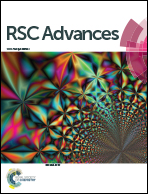‘Naked-eye’ colorimetric/fluorimetric detection of F− ions by biologically active 3-((1H-indol-3-yl)methyl)-4-hydroxy-2H-chromen-2-one derivatives†
Abstract
An improved synthetic protocol has been developed for the construction of highly functionalized heterologous alkyl and benzyl indolyl-coumarin derivatives through a rapid, catalyst-free and solvent-free one-pot three-component reaction of indole, aldehyde and 4-hydroxycoumarin. The synthesized compounds display a high selectivity and sensitivity towards F− ions. The detection of F− ions was accompanied by fluorescence quenching with noticeable colour change, which is evident from the Stern–Volmer plot. The Stern–Volmer plot shows an association constant of 6.2625 × 104 M−1 with a lowest detection limit (LOD) of 0.50 μM for F− ions. The interaction mechanism was studied by 1H-NMR titration and also supported by advanced TD-DFT calculations. The designed chemosensor has been utilized as a mini colorimetric kit for F− ions on test paper strips and is also capable of detecting F− ions in commercially available toothpaste and mouth rinser. The chemosensors also exhibited good antifungal and antibacterial activity.


 Please wait while we load your content...
Please wait while we load your content...